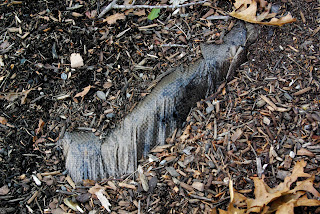 One of the most time consuming parts of our property's native landscaping project is the removal of an estimated 2400 square feet of plastic sheeting and about 4000 square feet of plastic landscape cloth we have inherited. I could leave it in place, but if my goal is to have the new perennials and ground cover fill in nicely then the plastic and landscape cloth must be removed. Its weed-blocking days are over. Plus, having 2400 square feet of impervious plastic under the soil is a terrible thing for a river bank property. In a heavy downpour the run off will go straight into the river and not soak into the soil, adding to flash floods and droughts.
One of the most time consuming parts of our property's native landscaping project is the removal of an estimated 2400 square feet of plastic sheeting and about 4000 square feet of plastic landscape cloth we have inherited. I could leave it in place, but if my goal is to have the new perennials and ground cover fill in nicely then the plastic and landscape cloth must be removed. Its weed-blocking days are over. Plus, having 2400 square feet of impervious plastic under the soil is a terrible thing for a river bank property. In a heavy downpour the run off will go straight into the river and not soak into the soil, adding to flash floods and droughts. This 750 square foot section of the back yard to the right is a giant square of mulch under which is a thick plastic tarp. In some areas the tarp is buried under 10 inches of mulch, in other areas it's poking right out of the ground (above). And in other areas there's fuzzy landscape cloth over the tarp. I'm leaving this section until later in the summer having learned how much work the plastic removal is.
This 750 square foot section of the back yard to the right is a giant square of mulch under which is a thick plastic tarp. In some areas the tarp is buried under 10 inches of mulch, in other areas it's poking right out of the ground (above). And in other areas there's fuzzy landscape cloth over the tarp. I'm leaving this section until later in the summer having learned how much work the plastic removal is.Last week I removed a small ten by four foot section of double-layered landscape cloth from an area along my neighbor's driveway. You can see the disturbed mulch below and the pile of landscape cloth I removed. Roots from the nearby oak tree had woven themselves right through the cloth attaching it to the mulch and making removing it extremely difficult. This small section took me over an hour.

 |
| BEFORE |
After the cloth was removed I enlarged the planting area by removing about 40 square feet of lawn along this bed (future post about lawn shrinking coming). I edged the whole area with bricks dug out from an old walkway in back which we're removing. Then I rewarded myself this weekend by planting this area out with a shade garden of foam flower, coral bells, soloman's seal, bearberry, leather wood ferns, white snakeroot and a lovely variegated hosta that was already here and I divided.
 |
| AFTER |
The almost-finished area is to the right. Once I move the old yew stumps sitting by the oak, and add mulch I will declare it done! I'm looking forward to seeing the foam flower and bearberry spread and fill everything out. In future years I hope this will be a beautiful and lush section of yard.

Don't get me started on the plastic. To put in our raised beds we had to move stone, a layer of cloth, pea gravel, then finally plastic. The hard part was because it was decayed we had to work slowly and in sections rather than my normal HULK SMASH AND PULL mode of earthmoving.
ReplyDeleteI know Beej, removing it is the biggest explicative I can think of. The next area I need to remove is about 1000 square feet and I'm seriously tempted to rent some kind of little Bobcat or something!
ReplyDeleteFor anyone reading this blog DO NOT put down plastic under your soil! it's not a good idea environmentally and if you want it out someday you will curse yourselves!